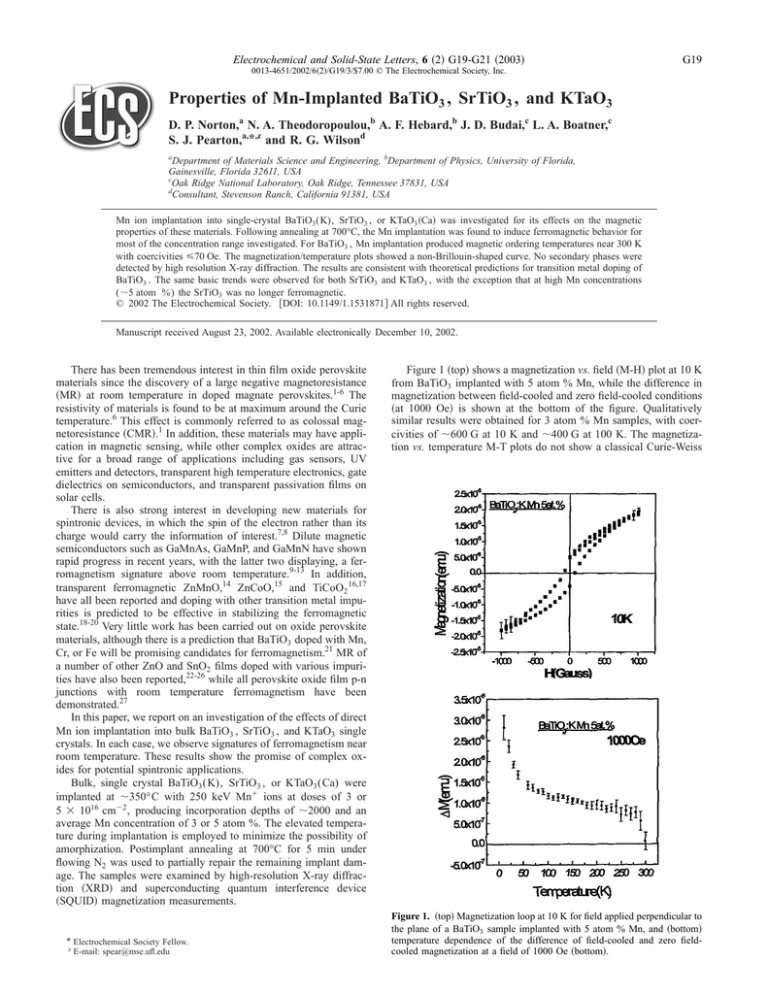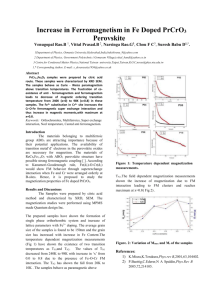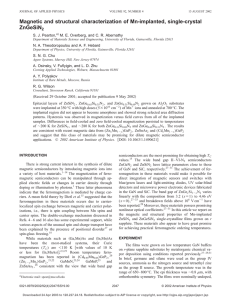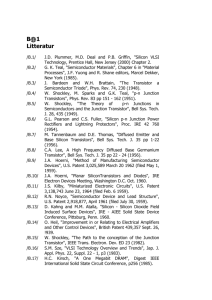
Electrochemical and Solid-State Letters, 6 共2兲 G19-G21 共2003兲
G19
0013-4651/2002/6共2兲/G19/3/$7.00 © The Electrochemical Society, Inc.
Properties of Mn-Implanted BaTiO3 , SrTiO3 , and KTaO3
D. P. Norton,a N. A. Theodoropoulou,b A. F. Hebard,b J. D. Budai,c L. A. Boatner,c
S. J. Pearton,a,*,z and R. G. Wilsond
a
Department of Materials Science and Engineering, bDepartment of Physics, University of Florida,
Gainesville, Florida 32611, USA
c
Oak Ridge National Laboratory, Oak Ridge, Tennessee 37831, USA
d
Consultant, Stevenson Ranch, California 91381, USA
Mn ion implantation into single-crystal BaTiO3 (K), SrTiO3 , or KTaO3 共Ca兲 was investigated for its effects on the magnetic
properties of these materials. Following annealing at 700°C, the Mn implantation was found to induce ferromagnetic behavior for
most of the concentration range investigated. For BaTiO3 , Mn implantation produced magnetic ordering temperatures near 300 K
with coercivities ⭐70 Oe. The magnetization/temperature plots showed a non-Brillouin-shaped curve. No secondary phases were
detected by high resolution X-ray diffraction. The results are consistent with theoretical predictions for transition metal doping of
BaTiO3 . The same basic trends were observed for both SrTiO3 and KTaO3 , with the exception that at high Mn concentrations
(⬃5 atom %) the SrTiO3 was no longer ferromagnetic.
© 2002 The Electrochemical Society. 关DOI: 10.1149/1.1531871兴 All rights reserved.
Manuscript received August 23, 2002. Available electronically December 10, 2002.
There has been tremendous interest in thin film oxide perovskite
materials since the discovery of a large negative magnetoresistance
共MR兲 at room temperature in doped magnate perovskites.1-6 The
resistivity of materials is found to be at maximum around the Curie
temperature.6 This effect is commonly referred to as colossal magnetoresistance 共CMR兲.1 In addition, these materials may have application in magnetic sensing, while other complex oxides are attractive for a broad range of applications including gas sensors, UV
emitters and detectors, transparent high temperature electronics, gate
dielectrics on semiconductors, and transparent passivation films on
solar cells.
There is also strong interest in developing new materials for
spintronic devices, in which the spin of the electron rather than its
charge would carry the information of interest.7,8 Dilute magnetic
semiconductors such as GaMnAs, GaMnP, and GaMnN have shown
rapid progress in recent years, with the latter two displaying, a ferromagnetism signature above room temperature.9-13 In addition,
transparent ferromagnetic ZnMnO,14 ZnCoO,15 and TiCoO2 16,17
have all been reported and doping with other transition metal impurities is predicted to be effective in stabilizing the ferromagnetic
state.18-20 Very little work has been carried out on oxide perovskite
materials, although there is a prediction that BaTiO3 doped with Mn,
Cr, or Fe will be promising candidates for ferromagnetism.21 MR of
a number of other ZnO and SnO2 films doped with various impurities have also been reported,22-26 while all perovskite oxide film p-n
junctions with room temperature ferromagnetism have been
demonstrated.27
In this paper, we report on an investigation of the effects of direct
Mn ion implantation into bulk BaTiO3 , SrTiO3 , and KTaO3 single
crystals. In each case, we observe signatures of ferromagnetism near
room temperature. These results show the promise of complex oxides for potential spintronic applications.
Bulk, single crystal BaTiO3 (K), SrTiO3 , or KTaO3 (Ca) were
implanted at ⬃350°C with 250 keV Mn⫹ ions at doses of 3 or
5 ⫻ 1016 cm⫺2 , producing incorporation depths of ⬃2000 and an
average Mn concentration of 3 or 5 atom %. The elevated temperature during implantation is employed to minimize the possibility of
amorphization. Postimplant annealing at 700°C for 5 min under
flowing N2 was used to partially repair the remaining implant damage. The samples were examined by high-resolution X-ray diffraction 共XRD兲 and superconducting quantum interference device
共SQUID兲 magnetization measurements.
* Electrochemical Society Fellow.
z
E-mail: spear@mse.ufl.edu
Figure 1 共top兲 shows a magnetization vs. field 共M-H兲 plot at 10 K
from BaTiO3 implanted with 5 atom % Mn, while the difference in
magnetization between field-cooled and zero field-cooled conditions
共at 1000 Oe兲 is shown at the bottom of the figure. Qualitatively
similar results were obtained for 3 atom % Mn samples, with coercivities of ⬃600 G at 10 K and ⬃400 G at 100 K. The magnetization vs. temperature M-T plots do not show a classical Curie-Weiss
Figure 1. 共top兲 Magnetization loop at 10 K for field applied perpendicular to
the plane of a BaTiO3 sample implanted with 5 atom % Mn, and 共bottom兲
temperature dependence of the difference of field-cooled and zero fieldcooled magnetization at a field of 1000 Oe 共bottom兲.
Electrochemical and Solid-State Letters, 6 共2兲 G19-G21 共2003兲
G20
Figure 2. 共top兲 Magnetization loop at 10 K for field applied perpendicular to
the plane of a SrTiO3 sample implanted with 3 atom % Mn, and 共bottom兲
temperature dependence of the difference of field-cooled and zero fieldcooled magnetization at a field of 500 Oe.
shape, but current theories suggest the shape of these plots is controlled by disorder in the sample, and any shape from concave to
linear to convex is possible.28 Note that the net magnetization
reaches zero at approximately room temperature. XRD showed no
evidence of other phases present in the implanted samples.
The ab initio total energy calculations for BaTiO3 doped with all
the 3d transition metals from Sc to Cu indicate that Mn, Fe, Cr, and
Co are the most promising candidates for achieving ferromagnetism
in conducting samples. While these calculations should be used as a
guide only due to hybridization effects and the high transition metal
concentrations assumed, they are in relatively good agreement with
our initial experimental data. The mechanism for the observed ferromagnetism is still not clear and may be due to bound magnetic
polarons28,29 or the carrier-induced magnetism inherent in the Zener
mechanism.20
While SrTiO3 samples with 5 atom % Mn showed paramagnetic
behavior, at the 3 atom % Mn concentration clear signatures of
ferromagnetism near 300 K were evident in the M-H and M-T plots
共Fig. 2兲. These results would be consistent with the Dietl et al.20
model in which the net magnetization is given by the difference
between the carrier-mediated ferromagnetism and the antiferromagnetic direct interactions between Mn⫹ ions. In this model, the Curie
temperature, T C , can be represented as
TC ⫽
effN OS 共 S ⫹ 1 兲  @ A F s兩 兩 2
⫺ T AF
12k B
where effNO is the Mn concentration,  is the strength of the interaction between the Mn and the carriers, is proportional to the
effective mass of the carriers, and T AF takes into account antiferromagnetic Mn-Mn interactions. Thus, the T C can decrease at high Mn
concentrations due to the increase in the latter contribution to the
magnetization.
Figure 3. 共top兲 Magnetization loop at 10 K for field applied perpendicular to
the plane of a KTaO3 sample implanted with 3 atom % Mn, and 共bottom兲
temperature dependence of the difference in field-cooled and zero fieldcooled magnetization at a field of 500 Oe.
In the disorder model,28,29 holes are allowed only to hop between
transition metal acceptor sites, and the interaction between the holes
and the magnetic ions is of the antiferromagnetic Heisenberg exchange type. The shape of the M-T plot is then determined by the
wide distribution of exchange couplings because of disorder because
some Mn atoms do not order until lower temperatures. This unusual
magnetization is in good agreement with our experimental data, as
shown in Fig. 1 and 2. Another interesting feature of this theory is
that with increasing randomness, the T C increases and the saturation
value of the magnetization is decreased.28,29 Within the same model,
if the carrier concentration is increased, the change of the magnetization becomes more Brillouin-like because the width of the exchange interaction decreases.30-33
Figure 3 shows the M-H 共top兲 and M-T 共bottom兲 plots from the
material implanted with 3 atom % Mn. Quantitatively similar results
were obtained for the 5 atom % condition. The magnetic ordering is
present to ⬃250 K and once again no additional peaks were observed in the XRD spectra from the samples.
In summary, three different oxide perovskites, BaTiO3 , SrTiO3 ,
and KtaO3 , show promising magnetic behavior when doped with
Mn by direct ion implantation. In each material, the Mn introduction
led to magnetic ordering temperatures ⭓250 K. The magnetization
has the opposite curvature to the usual Brillouin-like dependence on
temperature, as is predicted by a model that takes into account the
effects of disorder in dilute magnetic systems.28-33 In this model, the
ferromagnetism may arise from the interaction between magnetic
polarons in the case of either low carrier density or equivalently,
strong carrier localization.
Electrochemical and Solid-State Letters, 6 共2兲 G19-G21 共2003兲
Acknowledgments
The work at University of Florida is partially supported by the
National Science Foundation 共DMR-0101856 and DMR-0101438兲
and by the Army Research Office. Oak Ridge National Laboratory is
managed by UT-Battelle, LLC, for the U.S. Department of Energy
under contract DE-AC05-000R22725.
The University of Florida assisted in meeting the publication costs of this
article.
References
1. M. McCormack, S. Jin, T. H. Tiefel, R. M. Fleming, J. M. Phillips, and R. Ramesh,
Appl. Phys. Lett., 64, 3045 共1994兲.
2. S. Jin, T. H. Tiefel, M. McCormack, R. A. Fastnacht, R. Ramesh, and L. H. Chen,
Science, 264, 413 共1994兲.
3. R. von Helmolt, J. Lecker, B. Holzzappel, L. Schultz, and K. Samwer, Phys. Rev.
Lett., 71, 2331 共1993兲.
4. J. Z. Sun, L. Krusin-Elbauon, A. Cupta, G. Xiao, P. R. Duncombe, and S. S. P.
Parkin, IBM J. Res. Dev., 42, 89 共1998兲.
5. J. M. D. Coey, M. Viret, and S. von Molnar, Adv. Phys., 48, 167 共1999兲.
6. A. P. Ramirez, J. Phys.: Condens. Matter, 9, 8171 共1997兲.
7. S. A. Wolf, D. D. Awschalom, R. A. Buhrman, J. M. Daughton, S. von Molnar, M.
L. Roukes, A. Y. Chtchelhanova, and D. M. Treger, Science, 294, 1488 共2001兲.
8. H. Ohno, F. Matsukura, and Y. Ohno, JSAP Int., 5, 4 共2002兲.
9. S. Sonoda, S. Shimizu, T. Sasaki, Y. Yamamoto, and H. Hori, J. Cryst. Growth,
237-239, 1358 共2002兲.
10. G. T. Thaler, M. E. Overberg, B. Gila, R. Frazier, C. R. Abernathy, S. J. Pearton, J.
S. Lee, S. Y. Lee, Y. D. Park, Z. G. Khim, J. Kim, and F. Ren, Appl. Phys. Lett., 80,
3964 共2002兲.
11. M. L. Reed, N. A. El-Masry, H. H. Stadelmaier, M. E. Ritums, N. J. Reed, C. A.
Parker, J. C. Robarts, and S. M. Bedair, Appl. Phys. Lett., 79, 3473 共2001兲.
12. M. E. Overberg, B. P. Gila, G. T. Thaler, C. R. Abernathy, S. J. Pearton, N. A.
Theodoropoulou, K. T. McCarthy, S. B. Arneson, A. F. Hebard, S. N. G. Chu, R. G.
Wilson, J. M. Zavada, and Y. D. Park, J. Vac. Sci. Technol. B, 20, 969 共2002兲.
G21
13. N. A. Theodoropoulou, A. F. Hebard, S. N. G. Chu, M. E. Overberg, C. R. Abernathy, S. J. Pearton, R. G. Wilson, and J. M. Zavada, J. Appl. Phys., 91, 7499
共2002兲.
14. S. W. Jung, S.-J. An, G.-C. Yi, C. U. Jung, S.-I. Lee, and S. Cho, Appl. Phys. Lett.,
80, 4561 共2002兲.
15. K. Ueda, H. Tabota, and T. Kawai, Appl. Phys. Lett., 79, 988 共2001兲.
16. S. A. Chambers, S. Thevuthasan, R. F. C. Farrow, R. F. Marks, J. U. Thiele, L.
Folks, M. G. Samant, A. J. Kellock, N. Ruzycki, D. L. Ederer, and U. Diebold,
Appl. Phys. Lett., 79, 3467 共2001兲.
17. Y. Matsumoto, M. Murakami, T. Shono, T. Hasegawa, T. Kukomura, M. Kawasaki,
P. Ahmet, T. Chikyow, S.-Y. Koshihara, and H. Koimura, Science, 291, 854 共2001兲.
18. K. Sato and H. Katayama-Yoshida, Jpn. J. Appl. Phys., Part 2, 40, L334 共2001兲;
Mater. Res. Soc. Symp. Proc., 666, F4.6.1 共2001兲.
19. K. Sato and H. Katayama-Yoshida, Physica E (Amsterdam), 10, 251 共2001兲; Jpn. J.
Appl. Phys., Part 2, 39, L555 共2000兲.
20. T. Dietl, H. Ohno, F. Matsukura, J. Cibert, and D. Ferrand, Science, 287, 1019
共2000兲.
21. H. Nakagawa and H. Katayama-Yoshida, Jpn. J. Appl. Phys., Part 2, 40, L1355
共2001兲.
22. Z. Jin, K. Hasegawa, T. Fukumura, Y. Z. Yoo, T. Hasegawa, H. Koinuma, and M.
Kawasaki, Physica E (Amsterdam), 10, 256 共2001兲.
23. T. Wakano, N. Fujimura, Y. Morinaga, N. Abe, A. Ashida, and T. Ito, Physica E
(Amsterdam), 10, 260 共2001兲.
24. A. Tiwari, C. Jin, A. Kuit, D. Kumar, J. F. Muth, and J. Narayan, Solid State
Commun., 121, 371 共2002兲.
25. T. Fukmura, Z. Jin, M. Kawasaki, T. Shono, T. Hasegawa, and H. Koinuma, Appl.
Phys. Lett., 78, 958 共2001兲.
26. H. Kimura, T. Fukumura, M. Kawasaki, K. Innba, T. Hasegawa, and H. Koinuma,
Appl. Phys. Lett., 80, 94 共2002兲.
27. J. Zhang, H. Tanaka, and T. Kanai, Appl. Phys. Lett., 80, 4378 共2002兲.
28. M. Berciu and R. N. Bhatt, Phys. Rev. B, 65, 107203 共2001兲.
29. D. E. Angelescu and R. N. Bhatt, Phys. Rev. B, 65, 075211 共2002兲.
30. M. Berciu and R. N. Bhatt, Physica B, 312Õ313, 815 共2002兲.
31. A. C. Durst, R. N. Bhatt, and P. A. Wolff, Phys. Rev. B, 65, 235205 共2002兲.
32. R. N. Bhatt, M. Berciu, M. D. Kennett, and X. Wan, J. Supercond., 15, 71 共2002兲.
33. A. L. Chudnovskiy and D. Pfannkude, Phys. Rev. B, 65, 165216 共2002兲.







